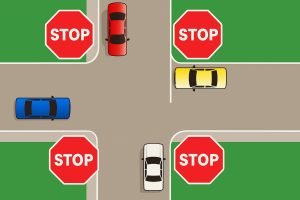Introduction
Four-way intersections, also called all-way stops, can confuse new drivers. The key to handling them safely is knowing the right-of-way rules. These rules help drivers decide who goes first and prevent collisions.
Step-by-Step Rules
Rule 1: First Come, First Served
-
The driver who arrives at the intersection first has the right-of-way.
-
Other drivers must wait their turn.
Rule 2: Yield to the Right
-
If two vehicles arrive at the same time, the driver on the left must yield to the driver on the right.
Rule 3: Straight Over Turning
-
When two cars arrive at the same time facing each other:
-
The car going straight has the right-of-way.
-
The car turning left must yield.
-
Rule 4: Right Turns vs. Left Turns
-
If one car is turning right and the other is turning left, the right-turning car goes first.
Rule 5: Pedestrians Always Win
-
Pedestrians in crosswalks always have the right-of-way, even if it means you wait longer.
Common Mistakes to Avoid
-
Waving another driver through when it’s not their turn (causes confusion).
-
Rolling through stop signs instead of making a complete stop.
-
Forgetting to check for pedestrians and cyclists.
Safety Reminders
-
Always make a complete stop at the stop line.
-
Make eye contact with other drivers when possible.
-
Be patient — rushing through can lead to accidents.
-
If there’s ever confusion, yield to avoid a crash.
Conclusion
At four-way intersections, right-of-way rules keep traffic moving safely and fairly. Remember:
-
First to arrive goes first.
-
If tied, yield to the right.
-
Straight beats turning.
-
Pedestrians always go first.

